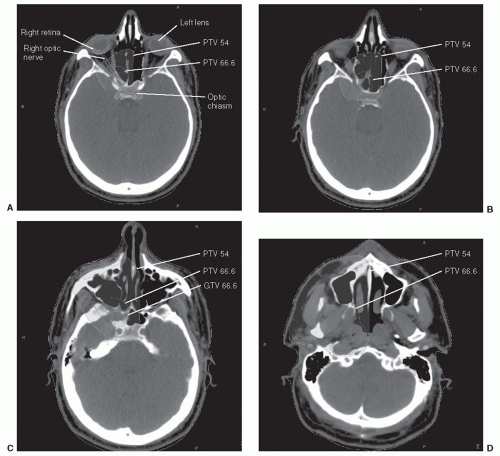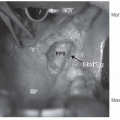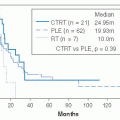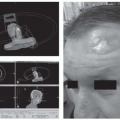Radiation Therapy Technique
Louis B. Harrison
James E. Dolan
Rudolph Woode
Kenneth S. Hu
Intensity-modulated radiation therapy has become the standard of care for the delivery of radiation therapy for cancers of the nasal cavity and the paranasal sinus complex. The close proximity of vital structures such as the orbital contents; ocular structures such as the retina, the optic nerve, and the lens; the brain stem; and the optic chiasm, all represent challenges.
Like any other anatomic area, it is important to assess the gross tumor volume (GTV) and the clinical tumor volume (CTV). However, the authors do not use a routine volume expansion to determine the planning target volume (PTV). The PTV design must be individualized for each patient, as the closeness of key structures factor into this determination. The opportunity to use image-guided radiation therapy (IGRT) has added to the radiation oncologist’s ability to design highly restricted PTVs and use daily imaging to verify position and fields and be tighter with margins. There is no general formula beyond observing the daily setup accuracy with IGRT, making the necessary shifts, and diligence to the interfaces between normal tissue and tissue at risk.
Basic technical issues are addressed in the body of the chapter in the section “Target Determination and Delineation” as well as “Radiation Therapy Technique—Dose Specification.” In this section, we will show several specific patient examples, along with the figures that show the anatomical distribution of tumor, the PTV, and the isodose display (Figs. 21-24 and 21-25). We will also show the dose-volume histogram display, so the doses to both target and vital normal organs can be reviewed.
 FIGURE 21-24. A 60-year-old male with a poorly differentiated carcinoma arising from the right side of the skull base. The tumor involves the sphenoid sinus, the ethmoid sinus, and the posterior aspect of the maxillary sinus and invades the posterior aspect of the right orbit. Tumor is very close to the right optic nerve as it enters the optic chiasm. The tumor did extend to the posterior nasal cavity. The stage was T4N0M0 AJCC stage IV. A: CT planning slice showing the optic chiasm, the right optic nerve, the retina, PTV 66.6, and PTV 54. The total dose used was 66.6 Gy at 1.8 Gy/fraction to the primary tumor volume plus margin (PTV 66.6). PTV 54 is an expansion of PTV 66.6. Care is taken to respect the anatomy as there is also a risk of total blindness due to the location of tumor near the optic chiasm. B: CT cut through the orbit showing PTV 66.6 and PTV 54. C: CT cut through the infraorbital area showing PTV 66.6, GTV 66.6, and PTV 54. Due to disease extent, PTV 54 is generous at this level, to include the entire right maxillary sinus and the nasal cavity with anterior expansion to the skin. D: CT cut through the midface showing PTV 66.6 involving the right pterygoid muscles, the pterygoid plates, and the most posterior nasal cavity. Again, PTV 54 represents a generous expansion to cover the entire right maxillary sinus, the anterior cheek/face, the skull base, the nasal cavity, and the preauricular area. This expansion covers routes of local disease progression and surrounding lymphatics. E: CT cut through the neck which shows PTV 54 including the neck nodes. Due to the advanced nature of the primary site, we delivered elective neck irradiation of 54 Gy at 1.8 Gy/fraction to the right-sided retropharyngeal nodes, as well as right levels 2, 3, and 4. F: Isodose distribution similar to Figure 1A above, showing coverage of PTV 66.6 with the 6,660 cGy isodose curve and coverage of PTV 54 with the 5,400 cGy isodose curve. The tightness of the coverage is noted due to the critical anatomy. The 5,000, 4,000, and 3,000 isodose lines are shown, which help protect the optic chiasm. G: Sagittal isodose display showing good coverage of PTV 66.6, PTV 54, protection of the spinal cord, the oral cavity, and the brain. H: Coronal dose distribution showing isodose display covering PTV 66.6 at the skull base; PTV 54 is well covered including the upper neck and the retropharyngeal nodes. I: Dose-volume histogram showing strong target coverage of PTV 66.6 and PTV 54, and respected tolerances of vital structures like the brain stem, the spinal cord, the optic chiasm, and the retina. A portion of the right optic nerve and the optic chiasm get higher doses because they are within PTV 66.6, as tumor is in these locations.
Stay updated, free articles. Join our Telegram channel
Full access? Get Clinical Tree
 Get Clinical Tree app for offline access
Get Clinical Tree app for offline access

|





